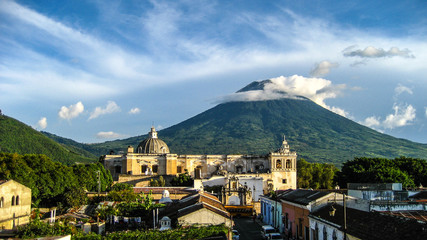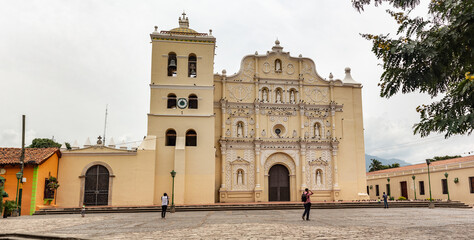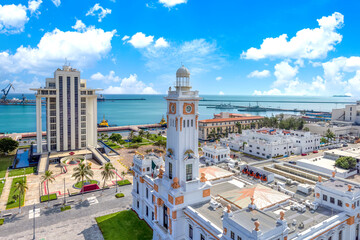From September 15th to October 15th, several countries including Costa Rica, El Salvador, Guatemala, Honduras, Nicaragua, Mexico, Chile, Belize, and Puerto Rico celebrate their independence days. This period is now recognized as Hispanic Heritage Month, a time to celebrate not only their independence but also to honor the rich histories, cultures, and contributions of American citizens whose ancestors originated from Spain, Mexico, the Caribbean, and Central and South America. Here, we present five captivating destinations that offer a deep dive into the diverse and vibrant heritage of these regions, perfect for exploring during Hispanic Heritage Month and beyond.

1. Cartago, Costa Rica
Cartago, once the capital of Costa Rica until an 18th-century volcanic eruption partially destroyed it, now stands as a cultural hub and a window into the nation’s history and natural beauty. Visitors can explore the ruins of temples, such as the Basílica de Nuestra Señora de los Ángeles, stroll across ancient stone bridges, and gain insight into life centuries ago by visiting preserved, centuries-old homes. Don’t miss the Ujarras Ruins, the country’s oldest church, nestled within breathtaking gardens.
For a deeper connection to the past, head to the Guayabo National Monument, a significant archaeological site showcasing the largest pre-Hispanic civilization in Costa Rica. Outside the historical site, you can explore nearby towns’ delightful eateries or embark on a hike up the towering Irazu volcano, which once engulfed the city and remains the nation’s highest active volcano.

2. Tazumal, El Salvador
El Salvador boasts impressive Mayan ruins that provide a glimpse into the country’s ancient civilization. Tazumal, a pre-Columbian Maya archaeological site in Chalchuapa, is over 7,000 years old and was abandoned around the 13th century. While much of the complex remains hidden, extensive restoration in the 1940s and 1950s has unveiled parts of this ancient wonder.
Nearby, Santa Ana, El Salvador’s second-largest city, offers a window into more recent history and local culture. Explore the neo-Gothic cathedral, erected in 1913 on the site where the original central parish was struck by lightning. Enjoy a cup of coffee from the cafes, as Santa Ana is a major center for the nation’s coffee exports.

3. Antigua, Guatemala
Antigua, a city dating back to the 16th century, is nestled amidst volcanoes, churches, and Baroque architecture, blending European and pre-Hispanic traditions. Designated as a UNESCO World Heritage Site, Antigua boasts attractions like the Arco de Santa Catalina, Central Park, and the Palacio del Ayuntamiento, which narrates the era when Antigua was Guatemala’s capital.
Antigua also boasts some of Guatemala’s finest restaurants and hotels, where the fusion of past and present is evident in its cuisine, such as the iconic dish pollo pipián, influenced by Mayan and Spanish flavors, and the fresh coffee sourced from nearby farms.

4. Comayagua, Honduras
While Honduras is renowned for its beaches, its quaint inland towns provide a unique insight into the nation’s history. Comayagua, once the capital, offers a captivating journey through time. Founded in the early 1500s, it features several museums, including The Comayagua Regional Museum and the Museum of Religious Art. A highlight is the central square’s ancient clock, dating back to the 12th century, the oldest in the continent.
Plan your visit during Holy Week in April to witness the vibrant celebration of the Virgin of the Immaculate Conception, where devout Christians create colorful “Alfombras” (carpets) from sawdust, each depicting a different religious scene, paying homage on Good Friday.

5. Veracruz, Mexico
Veracruz, known for its stunning beaches, is a natural wonderland with deep blue waves, powerful waterfalls, and desert-like dunes that symbolize our interconnectedness. Beyond its natural beauty, Veracruz has a rich historical heritage. It was here that the first Spanish expedition led by Juan de Grijalva landed over five centuries ago, resulting in a fusion of Hispanic, indigenous, Spanish, and Afro-Cuban cultures.
Visitors to Veracruz can enjoy “son jarocho,” a regional folk music style, in Downtown Veracruz’s Zocalo, where locals gather. Saturdays bring the traditional Danzón, a couples’ dance unique to this state. Savor gorditas, seafood dishes, and the famous café lechero (coffee with milk) in the city’s cafes, concluding your vacation on a truly epic note.
In Conclusion
Hispanic Heritage Month offers a unique opportunity to explore the rich tapestry of history, culture, and contributions from these diverse regions. These destinations not only provide a deeper understanding of their heritage but also offer unforgettable experiences that will stay with you long after Hispanic Heritage Month has passed.